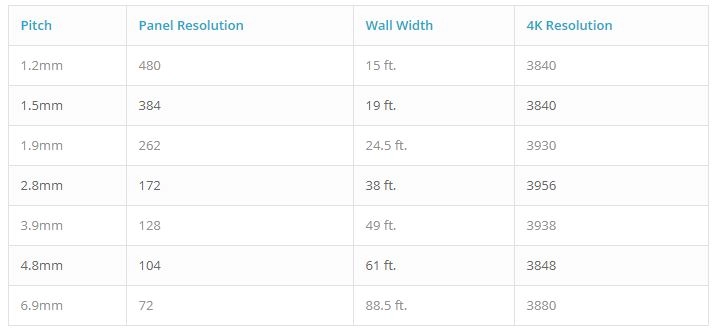4K LED VIDEO DISPLAYS OFFER ADVANTAGES OVER OTHER DISPLAY SCREENS
With countless displays types available on the market today, finding the right one for your unique application can be challenging, to say the least. From LEDs to LCDs to plasma, the choice in technology options can leave your head spinning. And now, there’s a new player on the field garnering much attention—4K. To help you find the right display, let’s explore exactly what 4K means and what it offers over other screen types.
4K Equals More Pixels
The resolution of any given screen is based on its pixel pitch. Pixel pitch describes the number of pixels within a display, measured by the distance in millimeters from the center of one pixel to the center of an adjacent pixel. A smaller pixel pitch indicates a higher density of pixels clusters with less distance between each individual pixel, translating to significantly improved resolution.
4K, or Ultra High Definition (UHD) as it’s also known, alludes to any display with a resolution of 3840 pixels by 2160 pixels. With a width that comes in just under 4,000 pixels, these displays have been dubbed 4K, boasting four times the pixels both horizontally and vertically than that of 1080p HD screens. This is the true differentiator between 4K and HD displays, as resolution reaped from more pixels encompassed within the same size screen delivers sharper, crisper imagery minus the pixelating effect.
4K Benefits Versus Other Displays
Several factors make 4K superior to other options, including:
- Resolving details: With enough pixels to fill four Full HD 1080p screens, 4K screens can display four times the level of detail with higher contrast, particularly evident in fine images like hair or feathers which may look blurry in non-4K screens.
- Closer viewing: When seen in close proximity, individual pixels within lower pixel count screens become evident, isolating imagery into sections that distort the viewer’s perception of the whole display. The multitude of pixels encompassed in a 4K screen allows for up-close viewing without pixelating, to deliver fine, detailed resolution regardless of distance.
- Scaling down: Often a video needs to be scaled down to a lower resolution. 4K videos downscaled to a 2K high definition output typically result in better final video quality than videos originally recorded in 2K.
Resolving details: With enough pixels to fill four Full HD 1080p screens, 4K screens can display four times the level of detail with higher contrast, particularly evident in fine images like hair or feathers which may look blurry in non-4K screens.
Closer viewing: When seen in close proximity, individual pixels within lower pixel count screens become evident, isolating imagery into sections that distort the viewer’s perception of the whole display. The multitude of pixels encompassed in a 4K screen allows for up-close viewing without pixelating, to deliver fine, detailed resolution regardless of distance.
Scaling down: Often a video needs to be scaled down to a lower resolution. 4K videos downscaled to a 2K high definition output typically result in better final video quality than videos originally recorded in 2K.
Why 4K is Ideal for Video Walls
With advances in fine pixel pitch LED displays, the ability to create displays at a 4k resolution has become much easier. In the past with pixel pitchs in the 5-8mm range screens would have to be extremely large, which in most applications is unrealistic for most people. Who has a 90ft + wide blank wall in a space?
Video walls enhance the ambiance of a space, creating a positive impact while providing the ideal medium to connect with team members, visitors, clients and the public. From providing vital informational messaging or streaming live events, to marketing your brand or creating eye-catching vibrant imagery that stimulates the senses, it’s easy to grasp why video walls are gaining in popularity at such an exponential rate.
Because beautiful, stunning imagery is the focus of your video wall, 4K technology is the perfect companion for these dynamic displays. 4K provides viewing experiences that far outshine standard HD capabilities, as seen in the 500 x 500 LED panel resolution examples below:

In recent weeks we saw a major player release a commercial 4K television display that is 189” diagonal. The advances in pixel pitch has allowed LED screen displays to be an afforabadle and comparable replacement for these types of large format screens and tv walls.
4K Video Wall Panels that Deliver High Resolution from PixelFLEX®
At PixelFLEX®, our process begins with your vision, offering industry-leading LED display technology and solutions to create a one-of-a-kind design that transforms your unique space into a digital world. With a wide variety of award-winning displays, PixelFLEX can create nearly any size and shape screen to meet your needs, ranging from 1-100mm in indoor, outdoor, and curvable configurations. Our FLEXUltra fine pixel pitch display is one of the highest resolution screens on the market, featuring flicker-free patented anti-moire mask technology, cable-free easy installation and maintenance, seamless, secure tile interlock, and more, making it the superlative 4K video wall partner. Further, PixelShield™ technology is an added protective coating which ensures maximum impact and scratch resistance, providing a significant decrease in pixel failure over the lifecycle of your FLEXUltra display.
Explore all the benefits of the FLEXUltra™ screen or learn more about why PixelFLEX has been selected as the design/deployment partner in a variety of industries for some of the most creative and innovative visual projects on display today.








